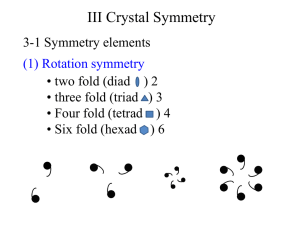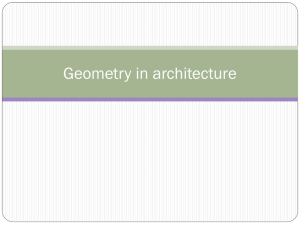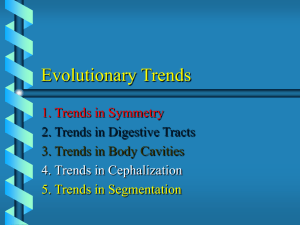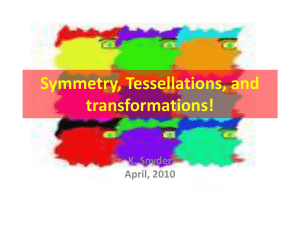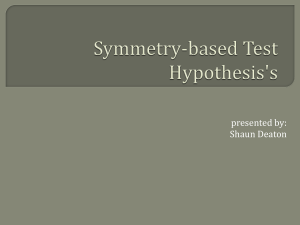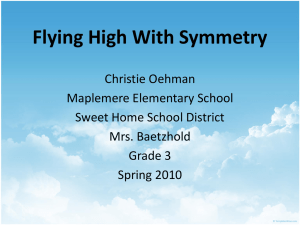*** 1
advertisement
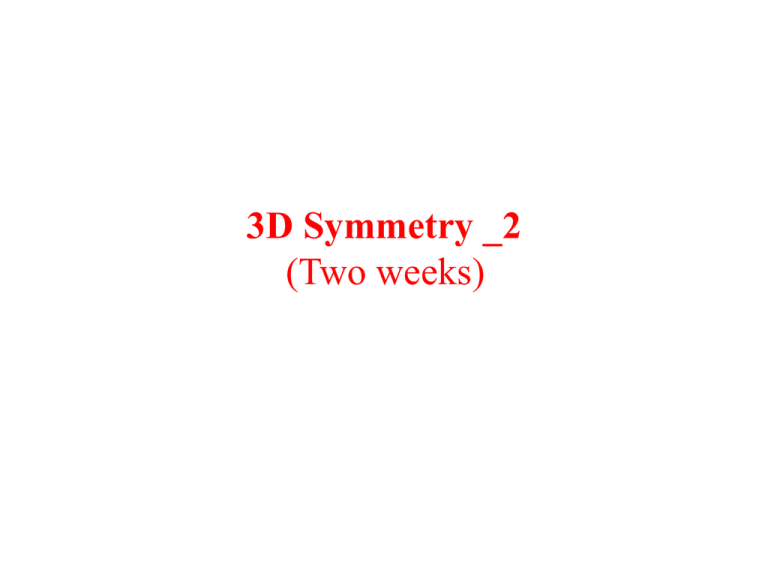
3D Symmetry _2
(Two weeks)
3D lattice: Reading crystal7.pdf
Building the 3D lattices by adding another translation
vector to existing 2D lattices
Oblique (symmetry 1) + T3
T2
T1
T1
T3
T2
1P
T1 T2 T3
T1 T2 T2 T3 T3 T1 General
Triclinic Primitive
triclinic
Oblique (symmetry 2) + T3
T2
T3
T1
T3 projection
Is this position OK? X
4 choices in order to maintain
2 fold rotation symmetry:
1 1
11
(00), (0 ), ( 0), ( )
2 2
22
(00) T3 0T1 0T2 z
T3
1
(0 )
2
'
T3
'
T3 2T3 T2
T3
Double cell
2P
side centered
T
T1
2
T2
T1
'
T1 T2 T3
2A
T
T
T
1
2
3
' '
T3 T2 T3 T1 90o
T3 T2 T3 T1 90o
'
T3 2T3 T1
'
1
T3
( 0)
Double cell
2
T3
side centered
1
T3 T1 0T2 z
T2
T1
2
2B
'
T1 T2 T3
' '
T3 T2 T3 T1 90o
11
(
)
22
1 1
T3 T1 T2 z
2
2
'
T3
'
T3 2T3 T2 T1
T3
Double cell
body centered
T2
T1
'
2I
T1 T2 T3
' '
T3 T2 T3 T1 90o T1 T2 general
Some people use
based centered,
some use body
centered.
2 A 2B 2I
2 P, 2 I
monoclinic
Rectangular (symmetry m) + T3
T3
T2
T1
90o
T1
90o
T2
T1 T2 T3
T1 T2 T3 T1 90o
1
T3 T1 yT2 z
2
2T3 T1 2 yT2 2z
2A
already exist!
Rectangular (symmetry g) + T3 : the same.
cm + T3 ?
Rectangular (symmetry 2mm) + T3
P2mm
T3
1 1
11
(00), (0 ), ( 0), (
)
P2mg
2 2
22
p2gg
1
1
11
(00 z ), (0 z ), ( 0 z ), (
z)
2
2
22
(00)
T1
T3
T2
222 P
T1 T2 T3
T1 T2 T3 T2 T3 T1 90o
Orthorhombic
primitive
'
T3
1
(0 )
2
'
T3 2T3 T2
T3
T1
T2
Double cell
side centered
'
T1 T2 T3
222 A
' '
T1 T2 T3 T2 T3 T1 90o
1
( 0)
2
'
T3
T1
Orthorhombic
base-centered
'
T3 2T3 T1
T3
T2
Double cell
side centered
222 B
'
T1 T2 T3
' '
T1 T2 T3 T2 T3 T1 90o
Orthorhombic
base-centered
11
(
)
22
'
T3
'
T3 2T3 T2 T1
T3
T2
T1
'
222 I
T1 T2 T3
T1 T2 T3 T2 T3 T1 90o
Orthorhombic
body-centered
222B, 222A
222C
rectangular
222 A 222 I
Centered Rectangular (symmetry 2mm) + T3
C2mm
1
1
11
(00 z ), (0 z ), ( 0 z ), (
z)
2
2
22
the same
(00z)
T1
11
(
z)
22
T3
T2
222C
T1 T2 T3
T1 T2 T3 T2 T3 T1 90o
T1
'
T3
T2
222C
'
T1 T2 T3
' '
T1 T2 T3 T2 T3 T1 90o
1
( 0 z)
2
'
T3
T1
T3
Face centered
T2
'
222 F
T1 T2 T3
' '
T1 T2 T3 T2 T3 T1 90o
222 P, 222 I , 222C , 222 F
orthorhombic
Square (symmetry 4, 4mm) + T3
P4
P4mm
p4gm
(00z)
T1
(00 z ), (
11
z)
22
T3
T2
T1 T2 T3
T1 T2 T3 T2 T3 T1 90o
Tetragonal
primitive
4P
1 1
T3 T1 T2 z
2
2
11
(
z)
22
'
T3
T1
T3
Tetragonal
Body centered
T2
4I
'
T1 T2 T3
' '
T1 T2 T3 T2 T3 T1 90o
4 P, 4 I
Tetragonal
Hexagonal (symmetry 3, 3m) + T3
T2
(00 z ), (
T1
p3
p3m1
(00z) Hexagonal primitive 3 P
21
3R
(
z ) Rhombohedral
33
21
z)
33
p31m
not in this category
Why?
(00z) Hexagonal primitive 3 P
T3
T2
T1
21
(
z ) Rhombohedral
33
T1 T2 T3
T1 T2 120o
T3 T2 T3 T1 90o
3R
T2
T1
triple cell
2/3
2/3
1/3
1/3
a = b = c;
= = 90o
Hexagonal (symmetry 3m, 6, 6mm) + T3
T2
T1
p6
p6mm
T3 can only located at positions:
(00z)
(00z) Hexagonal primitive 3 P
3P , 3R
p31m
Hexagonal & 6 related can only fit 3P!
11 lattice types already
cubic (isometric)
Special case of orthorhombic (222) with a = b = c
Check the 3 fold rotation symmetry in 111 direction
Primitive (P)
Body centered (I)
Face centered (F)
Base center (C)
23P, 23I , 23F
[100]/[010]/[001]
[111]
Cubic
Tetragonal (I)?
a=bc
Tetragonal (P)
Another way to look as cubic:
Consider an orthorhombic and requesting the diagonal
direction to be 3 fold rotation symmetry
222P 23P
Primitive
222I 23I
Body centered
222F 23F
Face centered
222C 23C
3 fold rotation symmetry does
not exist in base centered cell
Bingo!
14 Bravais lattices!
Lattice type - compatibility with - point group
reading crystal9.pdf.
Crystal Class
Bravais Lattices
Point Groups
Triclinic
P (1P)
1, 1
Monoclinic
P (2P), C(2I)
2, m, 2/m
P(222P), C(222C)
Orthorhombic
222, mm2, 2/m 2/m 2/m
F(222F), I(222I)
Rhombohedral P (3P), 3R
3, 3, 32, 3m, 32/m
6, 6, 6/m, 622, 6mm, 6m2,
Hexagonal
P (3P)
6/m 2/m 2/m
4, 4, 4/m, 422, 4mm, 42m,
Tetragonal
P (4P), I (4I)
4/m 2/m 2/m
Isometric
P (23P), F(23F), I
23, 2/m3, 432, 43m, 4/m32/m
(Cubic)
(23I)
=P
=TP
http://www.theory.
nipne.ro/~dragos/S
olid/Bravais_table.
jpg
=I
=TP
=I
=P
=B
http://users.aber.a
c.uk/ruw/teach/33
4/bravais.php
Next, we can put the point groups to the compatible
lattices, just like the cases in 2D space group.
3D Lattices (14) + 3D point groups 3D Space group
There are also new type of symmetry shows up in 3D
space group, like glide appears in 2D space (plane)
group!
The naming (Herman-Mauguin space group symbol)
is the same as previously mentioned in 2D plane group!
The first letter identifies the type of lattice:
•P: Primitive; I: Body centered; F: Face centered
•C: C-centered; B: B-centered, A: A-centered
The next three symbols denote symmetry elements in
certain directions depending on the crystal system.
(See next page)
Monoclinic
a b = 90o; c b = 90o.
b axis is chosen to correspond to a 2-fold axis of
rotational symmetry axis or to be perpendicular to a
mirror symmetry plane.
Convention for assigning the other axes is c < a. a c
is obtuse (between 90º and 180º).
Orthorhombic
The standard convention is that c < a < b.
Once you define the cell following the convention
A, B, C centered
Symmetry Direction
Crystal System
Primary
Secondary
Tertiary
Triclinic
None
Monoclinic
[010]
Orthorhombic
[100]
[010]
[001]
Tetragonal
[001]
[100]/[010]
[110]
Hexagonal/
Rhombohedral
[001]
[100]/[010]
[120]/[1 1 0]
Cubic
[100]/[010]/
[001]
[111]
[110]
Monoclinic + 2
Consider 2P Monoclinic + 2
2D
p2
P2
P2
/2
/2
1
T A B @ T
2
How about 2I Monoclinic + 2
c
A
T A ?
1
1
1
T a b c
2
2
2
b
a
There is a lattice point
in the cell centered!
T
T||
(3)
(2)
T
z (1)
T
z
A
(2)
T||
(1)
T
T A B ,
z +1/2 (3)
New type of operation
T||
1
@ T
2
1
1
a b
2
2
In general
T A , B ,1
Screw axis
2
21
1 T||
1
@ T
2
x (T / 2) cot( / 2)
A
1
T A B @ T
2
T A (T T|| ) A B ,T||
B
T
A
1
@ T
2
B ,T|| (3)
T
T||
(2) (1)
T A , (T T|| ) A , B , T||
1
@ T
2
(2)
A ,
T
B , T|| (3)
T
T||
(1)
T
Crystal diffraction 2.ppt page 31
B
1
T A B @ T
2
1
@ T
2
A
x
T
x (T / 2) cot( / 2)
T A (T T|| ) A B ,T||
1
@ T
2
B ,T||
A
x
T
x (T / 2) cot( / 2)
T A , (T T|| ) A , B , T||
1
@ T
2
x (T / 2) cot( / 2)
B , T||
A ,
x
T
A3 / 2,
1
T
3
Specifying T ,
m
T
n
1 2
0T , T , T ,
3 3
3 4
T , T ,....
3 3
T
n mT
4
3
1
T 0T , T T
3
3
3
T
For a 3-fold screw axis:
1 2
0T , T , T
3 3
3
31
32
2T
2
T
3
1 2 3
4-fold screw axis: 0T , T , T , T
4 4 4
41
41 42 43
1
T
4
T
3
T
4
43
T
42
T
2
T
4
n1
n2
1
2
T T
n
n
……...
nm-2
nm-1
m2
m 1
T
T
n
n
No chirality
2
21
4
41
3
31
42
43
32
6
61
62
63
64
65
62
T
Example to combine lattice with screw symmetry
D
A
B
C
A: 2-fold + translation
(to arise at B, C, or D)
T A , B , T||
P all T : T|| 0c or c
T A , B ,
Rotation symmetry of B, C, and D is the same as A.
A: 2
T A B
P + 2 = P2
T A ,c / 2 B ,c / 2
A: 21
21
P + 21 = P21
21
21
I + 2 = I2 or I + 21 = I21
A
E
1 1 1
T a b c
2
2
2
T A , B , c / 2
A: 2 E: 21
Same, only
shifted
A: 21 E: 2
T A ,c / 2 B ,c / 2c / 2 B
I2 = I21
Hexagonal lattice (P and R) with 3, 31, 32. Case P first!
A
{1 A2 / 3 A4 / 3}
B
'
T
C
B
C
''
T
'
T A2 / 3, B2' / 3,
''
T A2 / 3, C2' / 3,
All translations in P have
component on c of 0 or unity!
T|| 0c or 1c
'
T A4 / 3, 2 B4'' / 3, 2
''
T A4 / 3, 2 C4'' / 3, 2
B and C: same point; B and C: equivalent point;
Having
B2 / 3, , B4 / 3, 2
P3
P31
P32
Case R!
A
{1 A2 / 3 A4 / 3}
E
All translations of R has
component on c of 1/3 or 2/3!
'
T A2 / 3, D2' / 3, c / 3
''
T A2 / 3, E2' / 3, 2c / 3
A
3
31
32
0
c/3
2c/3
D
'
T
D
1/3
E
2/3
''
T
'
T A4 / 3, 2 D4'' / 3, 2 c / 3
''
T A4 / 3, 2 E4'' / 3, 2 2c / 3
D2' / 3, c / 3 E2' / 3, 2c / 3
2/3 c/3 2/3 2c/3
2/3 2c/3 2/3 c
2/3 c 2/3 4c/3
Screw at
D’ E’
31
32
3
32
3
31
Designation of
Space group
R3
R31 = R3
R32 = R3
Hexagonal lattice (P, R) + 3, 31, 32 P3, P31, P32, R3.
Square lattice P with 4, 41, 42, 43.
{1 A / 2 A A3 / 2 }
C
A
B
B
B
'
T
C
''
T
C
A
4
41
42
43
0
c/4
c/2
3c/4
B
/2 0
/2 c/4
/2 c/2
/2 3c/4
The translation of P have
component on c of 0 or unity!
'
T A / 2, B' / 2,
'
T A , 2 B'' , 2
'
T A3 / 2,3 B3''' / 2,3
''
T A / 2, C' / 2,
''
T A , 2 C'' , 2
''
T A3 / 2,3 C3''' / 2,3
B
0
c/2
c
3c/2
B
4
41
42
43
B
2
21
2
21
P4
P41
P42
P43
P4
P41
P42
P43
How to obtain Herman-Mauguin space group
symbol by reading the diagram of symmetry
elements?
First, know the Graphical symbols used for
symmetry elements in one, two and three
dimensions!
International Tables for Crystallography (2006). Vol. A,
Chapter 1.4, pp. 7–11.
http://www.kristall.unifrankfurt.de/media/exercises/Symbols-forsymmetryelements-ITC-Vol.A2.pdf
Symmetry planes normal to the plane of projection
Symmetry plane
Graphical symbol Translation
Symbol
Reflection plane
None
m
Glide plane
1/2 along line
1/2 normal to
plane
1/2 along line &
1/2 normal to
plane (2 glide
vectors)
1/2 along line, 1/2
normal to plane (1
glide vector)
1/4 along line &
1/4 normal to
plane
a, b, or c
Glide plane
Double glide
plane
Diagonal glide
plane
Diamond glide
plane
a, b, or c
e
n
d
1/2 along line
a, b, c
1/2 normal to
plane
a, b, c
n-glide
d-glide
e-glide
Symmetry planes parallel to plane of projection
Symmetry plane
Graphical symbol Translation
Symbol
Reflection plane
None
m
Glide plane
1/2 along arrow
a, b, or c
Double glide
plane
1/2 along either
arrow
e
Diagonal glide
plane
1/2 along the
arrow
n
Diamond glide
plane
1/8 or 3/8 along
the arrows
d
3/8
1/8
The presence of a d-glide plane automatically implies a
centered lattice!
Symmetry
Element
Identity
2-fold ⊥ page
2-fold in page
2 sub 1 ⊥ page
2 sub 1 in page
3-fold
3 sub 1
3 sub 2
4-fold
4 sub 1
4 sub 2
4 sub 3
6-fold
6 sub 1
6 sub 2
6 sub 3
Graphical Symbol
Translation
Symbol
None
None
None
None
1/2
1/2
None
1/3
2/3
None
1/4
1/2
3/4
None
1/6
1/3
1/2
1
2
2
21
21
3
31
32
4
41
42
43
6
61
62
63
Symmetry
Element
6 sub 4
6 sub 5
Inversion
3 bar
4 bar
6 bar
2-fold and
inversion
2 sub 1 and
inversion
4-fold and
inversion
4 sub 2 and
inversion
6-fold and
inversion
6 sub 3 and
inversion
Graphical Symbol
Translation
Symbol
2/3
5/6
None
None
None
None
64
65
1
3
4
6 = 3/m
None
2/m
None
21/m
None
4/m
None
42/m
None
6/m
None
63/m
c-glide
b
n-glide
1
2
1
2
a b
21
c
|| a
n
2
m c
|| c
21
2
|| b
b-glide
a
m
From the point group mmm orthorhombic
For orthorhombic: primary direction is (100), secondary
direction is (010), and tertiary is (001).
axis || a axis || b axis || c
plane a plane b plane c
lattice
C
2 21 2 21 21
m b c n m n
2 2 21
C
m c m
for orthorhombic:
2 21 ( n nm )
meabcnd
Cmcm
Short symbol
17
D2h
No. 17 orthorhombic
that can be derived
Principles for judging crystal system by space group
•Cubic – The secondary symmetry symbol will
always be either 3 or 3 (i.e. Ia3, Pm3m, Fd3m)
•Tetragonal – The primary symmetry symbol will
always be either 4, 4 , 41, 42 or 43 (i.e. P41212,
I4/m, P4/mcc)
•Hexagonal – The primary symmetry symbol will
always be a 6, 6 , 61, 62, 63, 64 or 65 (i.e. P6mm,
P63/mcm)
•Trigonal – The primary symmetry symbol will
always be a 3, 3 , 31 or 32 (i.e P31m, R3, R3c,
P312)
•Orthorhombic – All three symbols following
the lattice descriptor will be either mirror
planes, glide planes, 2-fold rotation or screw
axes (i.e. Pnma, Cmc21, Pnc2)
•Monoclinic – The lattice descriptor will be
followed by either a single mirror plane, glide
plane, 2-fold rotation or screw axis or an
axis/plane symbol (i.e. Cc, P2, P21/n)
•Triclinic – The lattice descriptor will be
followed by either a 1 or a (-1).
http://chemistry.osu.edu/~woodward/ch754/sym_itc.htm
What can we do with the space group information
contained in the International Tables?
1. Generating a Crystal Structure from its
Crystallographic Description
2. Determining a Crystal Structure from
Symmetry & Composition
Example: Generating a Crystal Structure
http://chemistry.osu.edu/~woodward/ch754/sym_itc.
htm
Description of crystal structure of Sr2AlTaO6
Space Group = Fm3m; a= 7.80 Å
Atomic Positions
Atom
Sr
Al
Ta
O
x
0.25
0.0
0.5
0.25
y
0.25
0.0
0.5
0.0
z
0.25
0.0
0.5
0.0
From the space group tables
http://www.cryst.ehu.es/cgibin/cryst/programs/nph-wp-list?gnum=225
32
f
3m
24
e
4mm
24
d
mmm
8
4
4
c
b
a
43m
m3m
m3m
xxx, -x-xx, -xx-x, x-x-x,
xx-x, -x-x-x, x-xx, -xxx
x00, -x00, 0x0, 0-x0,00x,
00-x
0 ¼ ¼, 0 ¾ ¼, ¼ 0 ¼,
¼ 0 ¾, ¼ ¼ 0, ¾ ¼ 0
¼¼¼,¼¼¾
½½½
000
Sr 8c; Al 4a; Ta 4b; O 24e
40 atoms in the unit cell
stoichiometry Sr8Al4Ta4O24 Sr2AlTaO6
F: face centered
(000) (½ ½ 0) (½ 0 ½) (0 ½ ½)
Sr
(000) (½½0) (½0½) (0½½)
8c: ¼ ¼ ¼ (¼¼¼) (¾¾¼) (¾¼¾) (¼¾¾)
¼ ¼ ¾ (¼¼¾) (¾¾¾) (¾¼¼) (¼¾¼)
Al
¾ + ½ = 5/4 =¼
4a: 0 0 0 (000) (½ ½ 0) (½ 0 ½) (0 ½ ½)
(000) (½½0) (½0½) (0½½)
Ta
4b: ½ ½ ½ (½½½) (00½) (0½0) (½00)
O
(000) (½½0) (½0½) (0½½)
x00
24e: ¼ 0 0 (¼00) (¾½0) (¾0½) (¼½½)
-x00 ¾ 0 0 (¾00) (¼½0) (¼0½) (¾½½)
0x0 0 ¼ 0 (0¼0) (½¾0) (½¼½) (½¾½)
0-x0 0 ¾ 0 (0¾0) (½¼0) (½¾½) (0¼½)
00x 0 0 ¼ (00¼) (½½¼) (½0¾) (0½¾)
00-x 0 0 ¾ (00¾) (½½¾) (½0¼) (0½0¼)
Bond distances:
Al ion is octahedrally coordinated by six O
Al-O distance
d = 7.80 Å
0.25 − 0 2 + 0 − 0 2 + 0 − 0 2 = 1.95 Å
Ta ion is octahedrally coordinated by six O
Ta-O distance
d = 7.80 Å
0.25 − 0.5 2 + 0.5 − 0.5 2 + 0.5 − 0.5
= 1.95 Å
Sr ion is surrounded by 12 O
Sr-O distance: d = 2.76 Å
2
Determining a Crystal Structure from
Symmetry & Composition
Example:
Consider the following information:
Stoichiometry = SrTiO3
Space Group = Pm3m
a = 3.90 Å
Density = 5.1 g/cm3
First step:
calculate the number of formula units per unit
cell :
Formula Weight SrTiO3 = 87.62 + 47.87 + 3
(16.00) = 183.49 g/mol (M)
Unit Cell Volume = (3.9010-8 cm)3 = 5.93
10-23 cm3 (V)
(5.1 g/cm3)(5.93 10-23 cm3) : weight in a
unit cell
(183.49 g/mole) / (6.022 1023/mol) : weight
of one molecule of SrTiO3
(5.1 g/cm3)(5.93 10-23 cm3)/
(183.49 g/mole/6.022 1023/mol) = 0.99
number of molecules per unit cell : 1 SrTiO3.
From the space group tables (only part of it)
6
e
4mm
3
3
1
1
d
c
b
a
4/mmm
4/mmm
m3m
m3m
x00, -x00, 0x0,
0-x0,00x, 00-x
½ 0 0, 0 ½ 0, 0 0 ½
0½½,½0½,½½0
½½½
000
http://www.cryst.ehu.es/cgi-bin/cryst/programs/nph-wplist?gnum=221
Sr: 1a or 1b; Ti: 1a or 1b
Sr 1a Ti 1b or vice verse
O: 3c or 3d
Evaluation of 3c or 3d:
Calculate the Ti-O bond distances:
d (O @ 3c) = 2.76 Å (0 ½ ½)
d (O @ 3d) = 1.95 Å (½ 0 0, Better)
Atom
Sr
Ti
O
x
0.5
0
0.5
y
0.5
0
0
z
0.5
0
0

